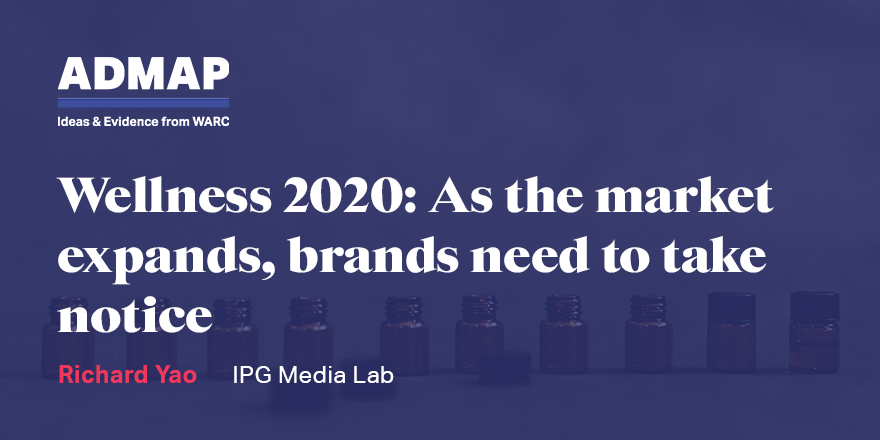The ten articles in January 2020’s Admap examine how digital is fuelling innovation in the health and wellness sector globally, from the emergence of new sub-categories like connected fitness, to AI-fuelled diagnosis. Catharine P. Taylor, US commissioning editor at WARC, looks at how what’s going on in health and wellness has resonance for marketers in general.
For most of the world, the arrival of January heralds the new year, and that time-honoured (but honoured not-for-long) tradition of the New Year’s resolution. If the commercials that typically flood the airwaves in January pushing weight loss plans are any indication, those resolutions often centre on health and wellness.
That made January the perfect time for Admap to focus on the category, particularly as it intersects with digital. Digital’s tools, and its ability to throw off ever more personal health data, has led to “a mindset of non-stop self-care” as one of our contributors, Richard Yao, writes. Indeed, the health and wellness sector both reflects and magnifies trends seen throughout marketing, as the decisions the category’s marketers make are so deeply personal and can even involve life and death.
Yao, who is IPG Media Lab’s manager of strategy and content, sets the stage in his piece, 'Wellness 2020: As the market expands, brands need to take notice.' He notes that the $4.5 trillion healthcare market is making brands – particularly lifestyle brands – react, as they incorporate wellness into their offerings.
Too often, digital healthcare communications are not user-focused, failing to take into account the digital and health literacy of the patient. In his article,'A data-driven and user-centred approach for health communication in the digital age,' Oliver Childs, managing director of Ark Communications, urges brands to carefully define their use case – being specific about exactly what they are trying to achieve and for whom.
Brands in healthcare and elsewhere often under-utilise social media, seeing it as another platform for programmatic buys. In ‘How to create radically relevant healthcare content that transforms campaigns into engagement systems,’ Michael Leis, chief content strategy officer of Publicis Health, offers an antidote; brands need to build a repeatable strategic model that emphasises creating and distributing content focused on helping patients take action. This allows them to better leverage the platforms and content types that most effectively support that behaviour.
‘Healthcare trendspotting: Current digital initiatives that portend our healthcare future’ by Wildtype Media Group CEO Juliana M. Chan Ph.D. and Dan Paris, regional director, business development at TBWA\Asia, expands on the theme of non-stop wellness. It highlights how digital has led to DIY health, including tools that track health habits, on-demand video consultation, and even diagnosis-by-chatbot.
It’s almost impossible to discuss healthcare marketing without wrestling with data. In her article, ‘How health brands can combine medical and consumer data to play a meaningful role in people’s lives,’ Hilary Gentile, global chief strategy officer of McCann Health, explores the need for healthcare marketers to manage both medical and consumer data, presenting unique challenges when it comes to privacy and integration.
Because of the exceptional need for privacy in healthcare data, consumers are taking stock of how well marketers are managing personal data. In her article, ‘Health data – and how attention to privacy is becoming a differentiator,’ Marie Stafford, European director of Wunderman Thompson’s Innovation Group explains that brands need to be privacy-first, and provide consumers with a sense of control and a fair value exchange.
Healthcare faces similar challenges to other categories in balancing long-term brand-building with short-term sales. In ‘Why healthcare brands can fall into a digital short-termist trap, and what they can do about it,’ Shann Biglione, Zenith’s EVP, head of strategy, outlines how they can manage brand-building marketing alongside more activation-driven initiatives.
Going forward, one opportunity for healthcare marketers is healthcare super apps, which offer a wide range of services, from consultations to prescriptions. In ‘The rise of Artificial Intelligence-enabled health platforms in China and what it means for healthcare brands’ by Nagendra Singh, director of digital & engagement strategy at McCann Health, Beijing, explains how disease education, a key patient engagement tool for pharma companies, may find new power on these platforms.
Healthcare marketers struggle with designing apps that can surmount this dismal statistic: 75% are abandoned after less than a week.
In ‘How to design healthcare apps that improve peoples’ lives, by thinking differently,’ Ross Taylor, head of healthcare for Rapp UK, explains that the keys to success are access, no matter what level of health literacy the patient has; a clear objective; and a basis in a proven methodology.
But even as healthcare solutions are benefiting from digital, there’s concern among consumers that digital devices have an overall negative impact on health, particularly mental health. Casey Ferrell, VP and head of US MONITOR at Kantar, illuminates consumers’ digital misgivings in ‘Taming technology: How to deliver digital well-being at human scale.’
In addition to the articles, WARC subscribers can also access a deck summarising the expertise and insights from all our contributors.


